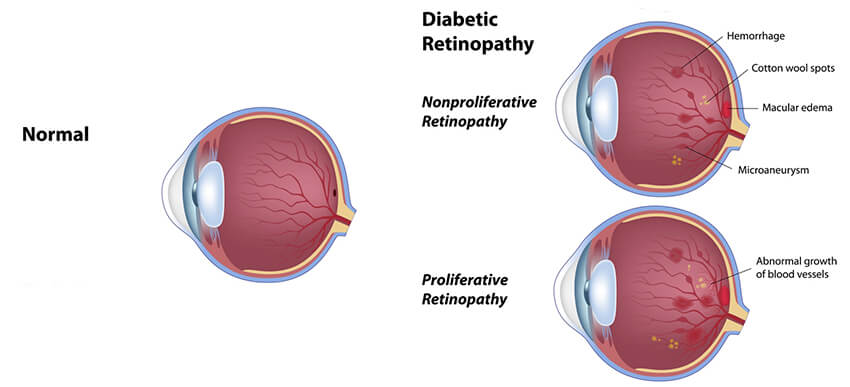Diabetes is an extremely common disease in the United States. As you may know, having diabetes makes you susceptible to many secondary issues, one being diabetic eye disease.
Diabetic eye disease is one of the most common causes of blindness in the United States. Regular eye examinations are important for people with diabetes because diabetic eye disease and the vision loss caused by it are completely preventable.
What Is Diabetic Eye Disease?
Diabetic eye disease refers to a group of diseases brought on by uncontrolled or prolonged diabetes. In people with uncontrolled diabetes, high blood glucose levels damage blood vessels throughout the entire body. Damage to blood vessels in the kidneys can cause kidney failure requiring dialysis. Damage to blood vessels in nerves can cause neuropathy. Your eye also has many blood vessels in it, and diabetes can damage those blood vessels too. In particular, high blood glucose levels cause damage to the blood vessels in the retina of the eye.

Diabetic Retinopathy
Diabetic retinopathy is a condition that causes the tiny blood vessels located in the retina to swell, leak and grow rapidly. This condition is the most common type of diabetic eye disease and is responsible for millions of cases of blindness. Diabetic retinopathy is progressive and gets worse over time without treatment.
The retina lines the back of your eye like wallpaper, acting like the film in a camera. It detects the light entering your eye and turns it into pictures for your brain to process and turn into images. When the retina’s blood vessels are damaged, the retina stops working properly. This can cause vision loss.
There are four stages of diabetic retinopathy:
- Mild Nonproliferative Retinopathy. During this stage, microaneurysms occur. Microaneurysms are small areas of swelling in the tiny blood vessels on the retina.
- Moderate Nonproliferative Retinopathy. During this stage, the blood vessels that nourish the retina become blocked.
- Severe Nonproliferative Retinopathy. During this stage, many blood vessels are blocked and cause the retina to become cut off from its blood supply. At this point, signals will be sent for the retina to start growing new blood vessels.
- Proliferative Retinopathy. The final and most severe stage of diabetic retinopathy. During this stage, your retina is growing new, abnormal blood vessels. These blood vessels swell and leak easily, causing fluid and blood to enter the eye cavity. This causes blind spots and vision loss.
After being exposed to high blood glucose levels for a long time, the blood vessels in the retina develop some weak spots along the blood vessels, which are called microaneurysms. Sometimes the microaneurysms rupture, and blood spills into the retina to form small hemorrhages. Your retina will eventually clear the blood away, but some debris is often left behind called exudates. This is the beginning of diabetic retinopathy. Most people with diabetes get these small changes in their eyes after having diabetes for 7 years or more.
If enough of the blood vessels rupture, the retina may not receive enough blood to keep it healthy. In this case, the retina will try to grow new blood vessels to replace the sick ones. Unfortunately, these new blood vessels are usually weak and leak easily. When these new blood vessels begin to grow, it is called proliferative diabetic retinopathy.
Proliferative diabetic retinopathy is less common than the beginning stages of diabetic retinopathy but is much more likely to take away some or all of your vision. If it is caught early, before your vision is damaged, proliferative diabetic retinopathy can be treated with laser therapy to save your vision. Once the vision is lost, it is very hard to get it back. Early proliferative diabetic retinopathy has no symptoms until vision loss occurs.

Example of Vision Loss From Diabetic Retinopathy
Diabetic Retinopathy Treatments
Because diabetic retinopathy presents no symptoms until vision loss occurs it is important to regularly get your eyes examined by your ophthalmologist. Here at Family Eye Physicians, we recommend that diabetic patients come in to see us once per year. Early diagnosis and treatment is key to saving your vision.
There are multiple ways diabetic retinopathy can be treated. Which treatment you receive depends greatly on the stage and severity of diabetic retinopathy and which treatments you respond best to. Our retina experts here at Family Eye Physicians are here to help diagnose and provide the perfect treatment plan for you. Sometimes, especially in the early stages, monitoring and controlling your blood glucose levels properly is enough. If not, we offer the following treatments for diabetic retinopathy.
- Injectable medication. Injections of anti-VEGF medication can stop the growth of new blood vessels and reduce swelling. This can slow vision loss and possibly improve vision. Steroid medication can also be used. These are injected into the eye. The number of injections you need will be determined by your doctor.
- Laser surgery. Laser surgery offers a minimally invasive way to stop the growth of new blood vessels. The laser can be used to seal off leaking blood vessels to stop blood from entering the eye cavity. The laser also helps shrink blood vessels to stop them from growing again.
- Vitrectomy. In cases of advanced diabetic retinopathy, your surgeon may perform a procedure called a vitrectomy. Some of the substance that fills the center of your eye, called the vitreous gel, can be removed along with the blood that is obscuring vision. Scar tissue can also be removed from the retina during the procedure.
If you are diabetic, remember that routine eye examinations are key to preventing diabetes-related vision loss. Contact Family Eye Physicians in Chicago to schedule your eye examination today!
 708.636.9393
708.636.9393
